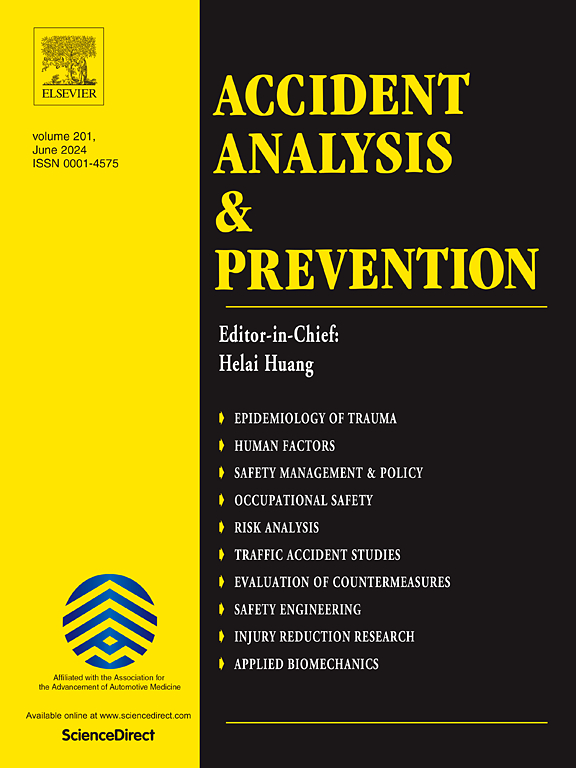Influencing factors of risky behavior in truck safety: A random parameter model incorporating trip-wise heterogeneity
IF 6.2
1区 工程技术
Q1 ERGONOMICS
引用次数: 0
Abstract
Truck-related crashes cause significant economic losses and casualties, making perception and control of truck driving risk a critical task for the logistics industry. However, heterogeneity in each truck trip is ignored in current studies, hindering precise prediction of truck driving risk. In this research, we defined trip-wise driving behavior as the driving characteristics extracted from real-time trajectory during a single trip, and investigated its impact on truck driving risk considering heterogeneity. Multi-source data were collected and aggregated, including on-board device data recording long-term trajectory and conflict events from 4,672 trucks in China, accompanied by high-resolution traffic environment data collected at the same time. We extracted trajectories on the same route for trucks within the selected fleet, and illustrated the existence of heterogeneity in trip-wise driving behavior using the Kruskal–Wallis test. A random parameter logit model was employed to study the influencing factors on truck driving risk, considering trip-wise heterogeneity. Results indicated that the heterogeneity of each truck trip was mainly reflected in standard deviation of trip-wise speed and environmental conditions (e.g., traffic speed, time of day). The effect of higher standard deviation of trip-wise speed varies significantly across trips, decreasing risk in 73.7% trips and increasing risk in 26.3% trips; this variability was shown through the normal distribution of the estimated parameter. Furthermore, heterogeneity shows the complex factors influencing truck driving risk and reveals overlooked patterns in long-term and trip-wise driving behavior, highlighting the importance of combining long-term behavior pattern with trip-wise behaviors for better risk prediction.
卡车安全危险行为的影响因素:一个包含行程异质性的随机参数模型
与卡车相关的碰撞事故造成了巨大的经济损失和人员伤亡,使得卡车驾驶风险的感知和控制成为物流行业的一项重要任务。然而,目前的研究忽略了卡车每次行程的异质性,阻碍了卡车驾驶风险的精确预测。在本研究中,我们将行程驾驶行为定义为从单次行程的实时轨迹中提取的驾驶特征,并考虑异质性,研究其对卡车驾驶风险的影响。收集并汇总了多源数据,包括记录中国4,672辆卡车的长期轨迹和冲突事件的车载设备数据,以及同时收集的高分辨率交通环境数据。我们在选定的车队中提取了相同路线上的卡车轨迹,并使用Kruskal-Wallis测试说明了在行程驾驶行为中存在异质性。考虑行程异质性,采用随机参数logit模型研究货车行驶风险的影响因素。结果表明,货车各行程的异质性主要体现在行驶速度和环境条件(如交通速度、时间)的标准差上。较高的行车速度标准差对不同行车风险的影响差异显著,73.7%的行车风险降低,26.3%的行车风险增加;这种可变性通过估计参数的正态分布来显示。此外,异质性显示了影响卡车驾驶风险的复杂因素,揭示了长期和出行行为中被忽视的模式,强调了将长期行为模式与出行行为相结合对于更好地预测风险的重要性。
本文章由计算机程序翻译,如有差异,请以英文原文为准。
求助全文
约1分钟内获得全文
求助全文
来源期刊

Accident; analysis and prevention
Multiple-
CiteScore
11.90
自引率
16.90%
发文量
264
审稿时长
48 days
期刊介绍:
Accident Analysis & Prevention provides wide coverage of the general areas relating to accidental injury and damage, including the pre-injury and immediate post-injury phases. Published papers deal with medical, legal, economic, educational, behavioral, theoretical or empirical aspects of transportation accidents, as well as with accidents at other sites. Selected topics within the scope of the Journal may include: studies of human, environmental and vehicular factors influencing the occurrence, type and severity of accidents and injury; the design, implementation and evaluation of countermeasures; biomechanics of impact and human tolerance limits to injury; modelling and statistical analysis of accident data; policy, planning and decision-making in safety.
 求助内容:
求助内容: 应助结果提醒方式:
应助结果提醒方式:


